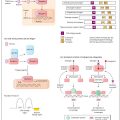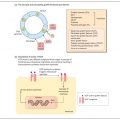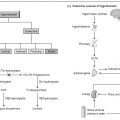Fertilization and i mplantation
The ovum and sperm pronuclei fuse to form the zygote, which now has the normal diploid chromosomal number (Fig. 27a). The zygote divides mitotically as it travels along the uterine tube, and at about 3 days after fertilization enters the uterus, when it is now a morula. The cells of the morula continue to divide to form a hollow sphere, the early blastocyst, consisting of a single layer of trophoblast cells and the embryoblast, an inner core of cells which will form the embryo. The trophoblast, after implantation, will form the vascular interface with the maternal circulation. After around 2 days in the uterus, the blastocyst is accepted by the endometrial epithelium under the influence of estrogens, progesterone and other endometrial factors. This embedding or implantation process triggers the ‘decidual response’, involving an expansion of a space, the decidua, to accommodate the embryo as it grows. The invasive trophoblast proliferates into a protoplasmic cell mass called a syncitiotrophoblast, which will eventually form the uteroplacental circulation. By about 10 days, the embryo is completely embedded in the endometrium.
If the ovum is fertilized and becomes implanted, the corpus luteum does not regress, but continues to secrete progesterone, and within 10–12 days after ovulation the syncitiotrophoblast begins to secrete human chorionic gonadotrophin
Stay updated, free articles. Join our Telegram channel

Full access? Get Clinical Tree








